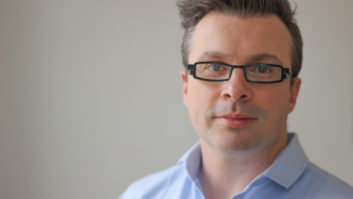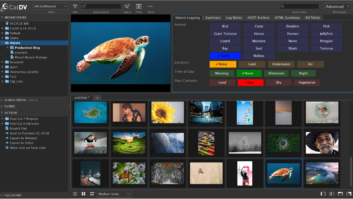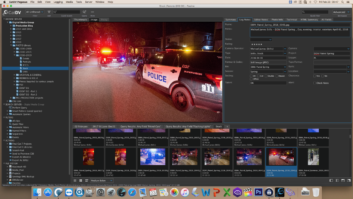Text has been updated to restore the audio/video link at the end of the story.
For several years in the 1970s I commuted from near Camden, N.J., to Baltimore, usually in the middle of the night. As I drove down I-95, KYW(AM), the all-news outlet in Philadelphia then owned by Westinghouse Broadcasting, was a regular companion, keeping me awake and informed.
KYW’s on-air people — less pontificating and definitely more locally focused than those of my other favorite, the BBC — used a professional, conversational tone and a calm, even vocal delivery. Behind the announcers’ voices and between news items, listeners could hear the cadence of teleprinting machines.
The station used this effect to add drama and credence as well as fill the voids between items as they spaced stories and information pieces apart.
Many radio newscasts in America at that time aired the sound of teleprinters, setting off the news from other program elements. Machines from the Teletype Corp. dominated newsrooms, with the company name placed boldly on the front. Most industry folks just called any printer a teletype machine.
Recently I dug out a 1960s-vintage aircheck (yes, Virginia, before I became an internationally recognized consulting engineer, I’d been a lowly disk jockey). During my news read one can hear the background sounds of teletypes — played off of audio cart — lending a compelling rhythm and aural authority to the headlines.
However, a young girl hearing this tape asked me, “What’s that noise in the background?” Ahh, what youth have missed.
Check the wire
When news on radio was an important program component and not just an interruption in an hour music sweep or rant, teletype machines were standard equipment, as common as a bathroom (although the machines probably were kept in better repair).
This had not always been the case. In radio’s infancy, stations for a time actually were forbidden to air news. Newspapers had forced the regulation into the books; they didn’t want the upstart technology to scoop their headlines or usurp their ad business and readers.
Eventually a symbiosis was reached wherein stations would air the headline and a little of the story, essentially a tease to get people to buy a newspaper for the “rest of the story.” The spread of radio into areas not covered by newspapers and a move by papers toward features and data brought a rescinding of restrictions on radio news altogether.
Stations also began acquiring news using their own resources, looking beyond the newspaper telegraph services or rewritten newspaper copy. Eventually stations started developing their own news services.
But how to get information from many different locations into the station? The answer was the radio news service teletype.
In 1914, the Associated Press had introduced the teletype machine using primarily telegraph wire circuits to disseminate news to and from member newspapers. Eventually membership was opened to radio stations, although few had origination capability.
When I entered radio, it was not unusual for stations to have multiple teletype machines, providing material from several sources. In my time, United Press International, the Associated Press, Reuters and the emergency weather wire of the National Weather Service were the usual suppliers of information that kept those teletypes in a constant cacophony.
Remote typewriter
A teleprinter, in its simplest description, was an electric typewriter commanded by a pulse chain sent sequentially (serially) down a pair of wires or aurally over a radio link. These units were cousins of today’s RS-232 standard serial computer printers.
In its debut version, a standardized Baudot code was used consisting of five bits for transmission items, such that 44 different characters and/or commands could be achieved. The code contained a regular, repetitive bit, a singular piece of positive information used to alert the decoding process that a character or command was coming. The ensuing bits of data selectively would activate small relays, setting up the striking of a particular typewriter key or activating a command such as ringing a bell once.
The first teletype used a code speed of 45.5 baud, the equivalent of about 60 words per minute. Later, the carrying capability of these machines and their connection circuits evolved, until teletypes of my generation (still just shortly after the dinosaurs ruled the earth, around 1967) were about 100 baud.
These wire services provided a near-instantaneous view of the world for stations and their listeners. Every word was made to count and the amount of material available was stunning.
For instance, at KELP(AM) in El Paso circa 1968, the AP wire transmitted the headline summary at, say, 15 minutes after the hour, so that these could be used in a 20-20 news format (with news at 20 minutes after and 20 minutes of the hour) or headlines at the half hour.
A pre-written 3-1/2 minute (average delivery speed) story block was transmitted at something like 15 minutes before the hour, to be used in a five-minute, on-the-hour newscast (3-1/2 minutes of news, 30 seconds of commercial, 30 seconds of sports, 15 seconds of weather with bumpers including the open and close billboards filling the five minutes).
Filling the wire throughout the day were sports, stock closings, obits of famous people sent in advance for the file, backgrounders, human interest stories, almanac copy, pronunciation guides, even jokes.
There was a small time slot in which all the radio newsroom teletypes in Texas would be fed Lone Star material from the Texas AP or UPI bureaus in Dallas or the capital, rather than the national wire.
It tolls for thee
The “bell” was an interesting feature, its sequence of rings famously announcing an important story.
For example, a ring of four bells on UPI wire service machines meant an “Urgent” message, five bells was a “Bulletin” and 11 bells was a “Flash,” used only for really big news. An 11-bell signal usually meant that the story was so significant that it required immediate airing and might even change history. Such bells might herald war or the death of a president.
Newsrooms of the day, and KELP was no exception, were filled with hanging files of copy “to be used,” boxes of marked-up copy that had aired (the lawyers, even then, wanted every word read on air saved to avoid liability) and huge trash cans full of printer paper, material that would not be or could not be used.
With the din of all those machines in the KELP newsroom, news announcers like gravel-voiced former Master Sgt. Ed Gilbow would work close to the mic, giving our news an urgent gravitas enhanced by the teletypes’ paradiddle in the background.
News teletype went to quiet hot print or dot matrix technology fed by satellite circuits in the early 1980s, replacing clack-clack with zip-zip. In the 1990s paper could be eliminated altogether and a wire service could send copy direct to word processor, with not a scissor, eraser or trashcan needed.
Although the staccato tattoo of the teletype generally is absent now, its nuance is still felt in the music of many news programs and the theme that has appeared in every James Bond picture since “From Russia With Love.” In New York, listeners to WINS(AM) still hear the sound effect of the teletype under the news copy.
But newsrooms today are far quieter places. The electronic cutting and pasting of stories compiled from diverse information sources including the Internet mimics the sound of silence. The choir of striking keys pounding out the history of the day is long gone, forgotten by most.
Another time we’ll talk about the technical details of how these teletypes worked, including the differentiation of receive-only and receive-send systems.
If you have never heard a teletype machine or would like a few moments of aural nostalgia, take a look and listen to this link.
Update: KYW(AM) stopped using its teletype sound effect in 2020.
Share your recollections of the teletype and its environs. E-mail [email protected].
Charles S. Fitch, W2IPI, is a registered professional consultant engineer, member of the AFCCE, senior member of the SBE, lifetime CPBE with AMD, licensed electrical contractor, former station owner and former director of engineering of WTIC(TV) in Hartford, Conn., and WHSH(TV) in Boston.










